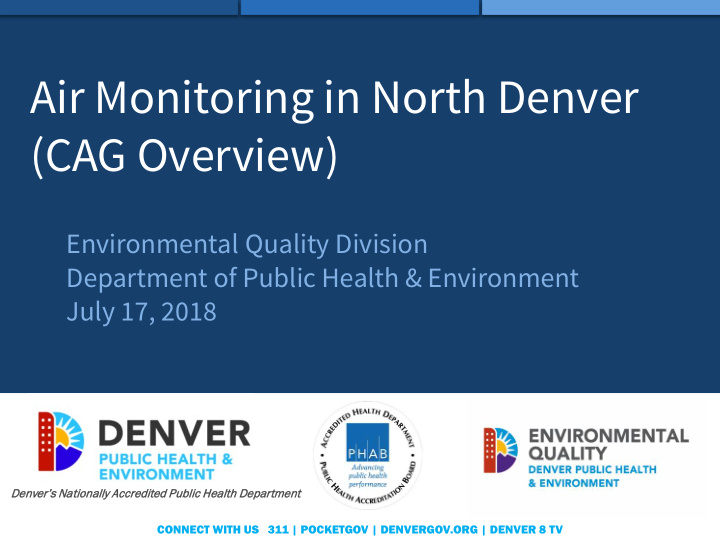



Air Monitoring in North Denver (CAG Overview) Environmental Quality Division Department of Public Health & Environment July 17, 2018 Denver’s ’s N Nationally lly A Accredited P Publi lic H Healt lth D h Department CONNECT WITH US 311 | POCKETGOV | DENVERGOV.ORG | DENVER 8 TV
Requested Discussion Topics ► Overview of monitoring ► Air monitoring data network management ► Swansea Air Monitoring Data ► Elevated Pollution Days ► Labor Day weekend 2017 (Sept 4 in particular) ► November 10, 2017 ► January 4, 2018 ► February 22, 2018
Globeville Landing Outfall Projects Central 70 Overview OU1, OU2, OU3 Four air quality monitoring projects
Swansea Air Monitoring Station Goal: Develop a better understanding of ongoing cumulative air quality impacts associated with major highway construction Measures Pollutants: CO, NOx, PM 2.5 , PM 10 , Black Carbon, VOC’s Frequency: Minute for criteria 425 ft pollutants, 5 min BC, 30 min VOC’s Collaborators: 260 ft Denver Department of Public Health & Environment Colorado Department of Transportation Colorado Department of Public Health and Environment Schedule: Start: April 1, 2017 End: 1 year after end of construction (there will be future phases during and after construction)
Network Management
Data – PM Focus PM10 STD PM2.5 STD
Report View CO NO 2 PM 10 PM 2.5 BC
Elevated Pollution Days
Elevated Pollution Days in Denver Key ingredients • In Denver’s case, river valley next to mountains • Cold air is more dense and sinks into the valley • Temperature inversions (occur year round, strongest in fall and winter) • Clear skies (night) or high clouds (day) that partially block the sun • Light or stagnant winds • Wildfire smoke (summer and fall) • Enough terrain variation in Metro Denver that high pollution is frequently but not always Metro-wide
Temperature Inversions Inversions act as a lid on the atmosphere • With surface heating after sunrise, • inversions usually break by mid morning Mobile source pollution gets trapped • below the inversion
High Pollution Days over Past 12 Months • Labor Day weekend 2017 (Sept 4 in particular) • November 10, 2017 • January 4, 2018 • February 22, 2018 • Without wildfire impacts, PM levels greatest in winter, followed by fall, summer, and spring in that order • Need to evaluate regional monitors to determine if it is a regional or local event • Visibility cameras and new satellite images are helpful as well
September 4, 2017 (Labor Day) Longmont • Heavy smoke from Pacific NW wildfires • Impacts over entire weekend Boulder • Peaked on Labor Day behind a dry cold front • Due to holiday, clearly not a mobile or industrial source driven event • All 4 GLO monitors high as well • Regional impact from Fort Collins to Chatfield Chatfield
Sept 4, 2017 (Labor Day) – Wildfire Smoke
Sept 4 2017(Labor Day)– Visibility Camera Can’t see the mountains!
November 10, 2017 Longmont • All day inversion • Greater impacts in the S Platte River valley Boulder from Denver-Greeley • Greeley 24-hr Avg = 35 (not shown on map) • Typical urban pollution sources all contributing Chatfield
Nov 10 2017– Visibility Camera Can barely see the mountains; highest PM near the surface
January 8, 2018 Longmont • All day inversion • Highs temps mid 40s • Greatest impacts in the S Boulder Platte River valley Denver- Greeley • Greeley 24-hr Avg = 35 (not shown on map) • Boulder, Longmont, and Chatfield are not in the inversion or as long • High clouds all day until ~2 pm Sun could not heat surface • Chatfield and erode the inversion
Jan 8 2018 – Visibility Camera Strong, shallow inversion impacting ground level monitors.
February 22, 2018 Longmont • All day inversion • Greatest impacts in the S Platte River valley from Boulder Chatfield-Greeley • Greeley 24-hr Avg = 30 (not shown on map) • High temps low-mid 20’s • Cloudier as day went on • Light snow by 4 pm • Sun could not heat surface and erode the inversion Chatfield
Feb 22 2018 – Visibility Camera Cant see the mountains, 60% humidity and aerosols (PM) making for ext. poor visibility
Recommend
More recommend